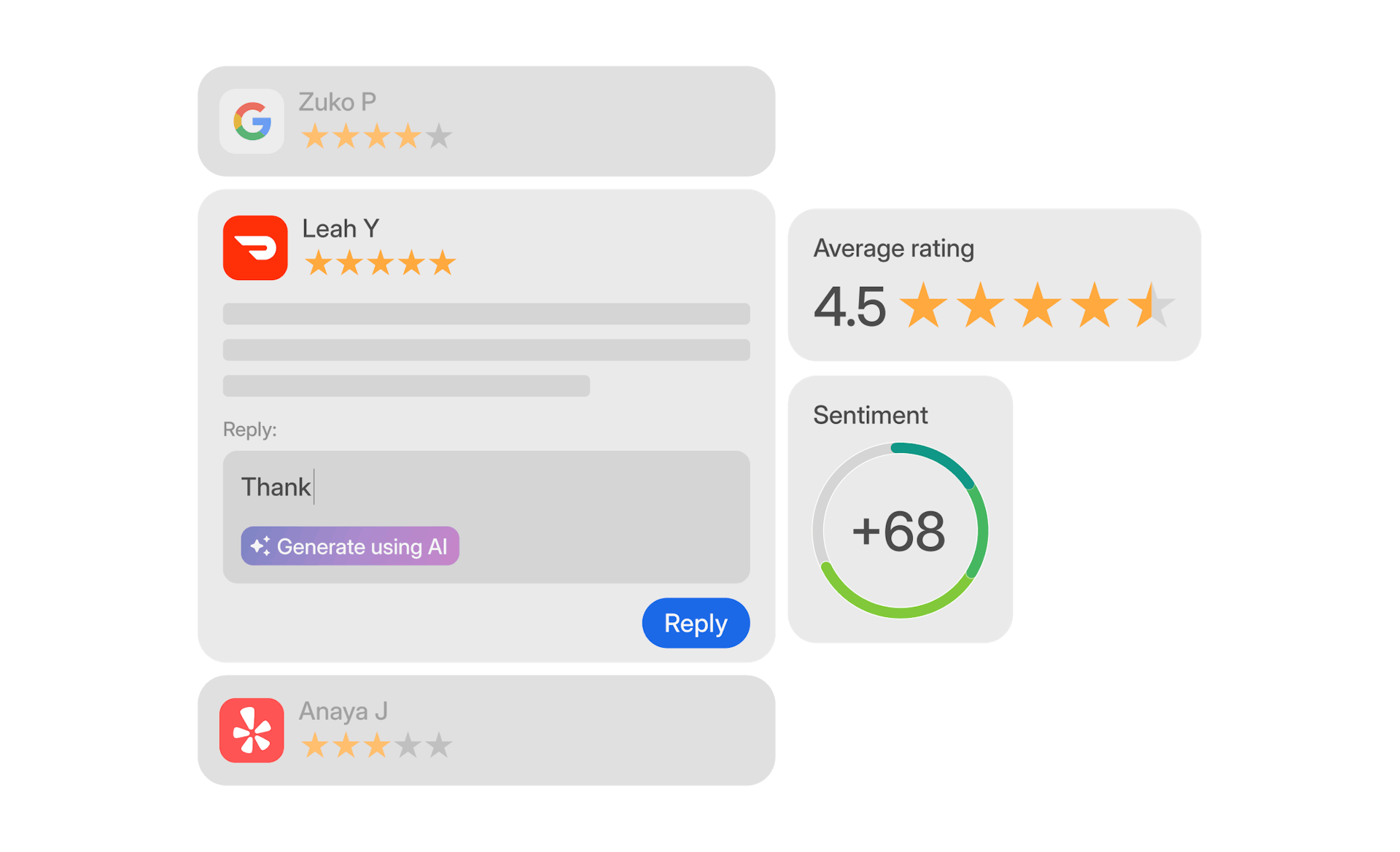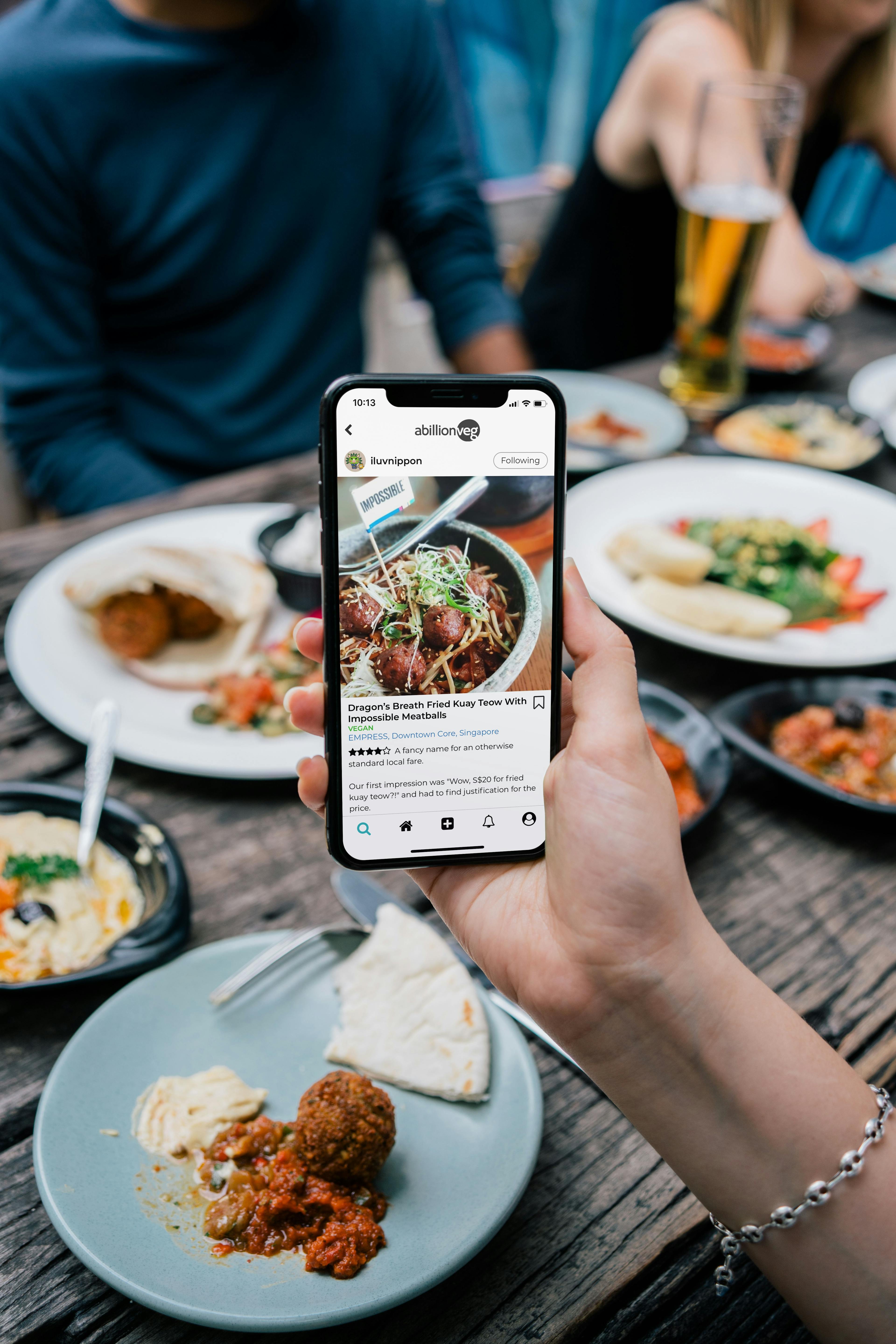
Nearly 94% of diners consult online reviews before deciding where to eat, industry data shows (1). While that number seems high, here’s an even more telling stat: restaurants with higher review ratings see 13% more revenue than their lower-rated competitors (2). In other words, your restaurant's online reputation directly impacts your bottom line, and reputation management is crucial.
Online reputation management for restaurants is the strategic process of monitoring, responding to, and influencing what customers say about your restaurant business across review platforms and social media. It's about turning satisfied customers into vocal advocates and actively addressing concerns before they damage your brand.
The stakes couldn't be higher for restaurant owners. A single negative review can cost a restaurant potential customers, while consistently positive reviews drive reservations, builds trust, and improve local SEO rankings. That's why successful operators in the restaurant industry consider reputation management a core business priority—not an afterthought.
Why listen to us? Because Otter has helped thousands of restaurants build stronger online reputations through proven strategies and smart technology. This guide shares the most effective techniques we've seen work across independent restaurants, regional chains, and enterprise brands.
Why a positive online image drives restaurant success
Think of your restaurant's online presence as a revenue driver that compounds over time. Seeing that 72% of consumers trust a local restaurant more when they see positive reviews (3), it’s important to create a cycle where satisfied customers become repeat customers, and vocal advocates bring friends and family through word-of-mouth.
The financial impact is immediate and measurable. Restaurants that maintain a 4.5-star rating or higher see significantly more reservations, walk-ins, and delivery orders than competitors with lower ratings. Customer reviews also extend customer loyalty by building the trust that turns first-time diners into regulars.
Conversely, bad reviews carry disproportionate weight in customer decision-making. A single one-star review can deter up to 22% of potential customers from visiting your restaurant (4), and the damage often persists for months. Poor online reputation costs your business both individual sales and years of brand building and community relationships.
Beyond direct customer influence, your restaurant's online reputation determines how easily people can find your restaurant in the first place. Google's local search algorithm heavily weighs review quantity, quality, and recency when ranking restaurants for "near me" searches. Restaurants with consistently positive reviews and active owner responses rank higher in local results, appearing first when hungry diners search for dining options in your area.
In the restaurant industry where word-of-mouth has always been king, customer reviews have simply amplified and accelerated the process. The restaurants that understand this—and actively manage their digital reputation—consistently outperform those that leave their online presence to chance.
Main platforms shaping your restaurant's reputation

Your online reputation lives across multiple review platforms, each with distinct audiences and ranking factors. Understanding how diners use these review sites, and optimizing your presence accordingly, ensures your restaurant appears at its best wherever potential customers are looking.
- Google Business Profile dominates local restaurant discovery. When someone searches "restaurants near me" or your cuisine type, Google's results determine whether they find you or your competitor first. High ratings and frequent Google reviews boost your search ranking, while complete business listings and regular photo updates signal to Google that you're an active, trustworthy business.
- Optimization priorities: Claim your listing, verify your location, upload high-quality photos of signature dishes and your dining space, respond to every review, and post regular updates about specials or events.
- Yelp remains influential in urban markets and among dedicated foodies who trust detailed restaurant reviews over quick star ratings. Yelp's algorithm favors businesses with consistent review activity and authentic owner engagement.
- Optimization priorities: Complete every section of your business profile, highlight unique features like "farm-to-table" or "family-friendly," keep menus current, and respond thoughtfully to customer feedback. Use relevant keywords in your business description.
- TripAdvisor captures both tourists and locals, especially near hotels, attractions, and downtown areas. Detailed reviews and user photos heavily influence booking decisions for special occasions and group dining.
- Optimization priorities: Encourage satisfied customers to share their guest experience with photos, keep your menu and contact information updated, and highlight what makes your restaurant special, especially if it's live music, outdoor seating, or locally-sourced ingredients.
- Facebook leverages social connections, making recommendations from friends particularly powerful. Reviews here often include personal stories and longer descriptions that build emotional connections with potential customers.
- Optimization priorities: Post regular updates about menu changes and events, respond to comments and messages quickly, share behind-the-scenes content, and encourage satisfied customers to recommend your restaurant to their networks.
- OpenTable and Zomato attract diners ready to make reservations, often for special occasions or planned meals. These platforms emphasize convenience and detailed information about dining experiences.
- Optimization priorities: Ensure reservation systems work seamlessly, keep menus and pricing accurate, showcase your ambiance with professional photos, and respond to guest feedback to demonstrate your commitment to customer satisfaction.
- Instagram shapes perception through visual storytelling. While not a traditional review platform, user-generated content here influences dining decisions, especially among younger demographics who discover restaurants through hashtags and location tags.
- Optimization priorities: Maintain a cohesive visual brand, repost customer photos (with permission), use location tags and relevant hashtags, and create Instagram-worthy moments that encourage guests to share their dining experience.
Each platform requires a tailored approach, but the fundamentals remain consistent: accurate information, compelling visuals, and genuine engagement with your community.
Actionable ways to strengthen your online presence

Building strong restaurant reputation management requires consistent effort across multiple touchpoints. These proven strategies help you take control of your brand narrative while creating more opportunities for positive customer feedback.
1. Claim and optimize every online profile
Start by securing your restaurant's presence on all major review sites where potential customers might look for you. Inconsistent information confuses potential diners and hurts your SEO rankings.
Create a master document with your restaurant's exact name, address, phone number, hours, website, and menu details. Use this information identically across all platforms and check quarterly for accuracy.
Upload high-quality photos that showcase your best dishes and dining atmosphere. Refresh images regularly to keep profiles current.
2. Build a systematic review request process
Most satisfied customers won't leave reviews unless asked, but a polite request at the right moment can significantly increase your review volume.
Train your staff to identify guests who've had exceptional customer experiences and mention during payment: "We'd love to hear about your experience on Google if you have a moment."
Follow up with email campaigns or SMS for guests who've provided contact information. Send a thank-you message within 24 hours that includes direct links to your review profiles.
3. Respond to every review within 24-48 hours
Consistent review response times show potential customers that you value customer feedback and stay engaged with your community. Both positive reviews and negative reviews deserve acknowledgment.
For positive reviews, thank the customer by name, mention specific details they shared, and invite them back. For negative feedback, respond professionally with empathy, take responsibility where appropriate, and offer to resolve the issue offline.
Create response templates for common scenarios, but personalize each reply to avoid sounding robotic. Your response tone should match your restaurant's brand personality while remaining professional.
4. Turn negative feedback into improvement opportunities
Negative reviews often provide your most valuable customer feedback. Customers who take time to write detailed complaints are giving you free consulting on operational issues.
Look for patterns in criticism, like repeated mentions of slow service or specific dish quality issues. Use this feedback to guide staff training or operational changes.
Document common complaints and your solutions so your team can address issues before they reach the public review stage.
5. Showcase positive experiences on social media
Happy customers love seeing their guest experiences celebrated, and social proof encourages others to visit and share their own stories.
With customer permission, repost photos and positive reviews on your Instagram stories and Facebook page. Tag the original poster and thank them publicly. Create highlight reels of customer photos to give your social media platforms authentic, user-generated content.
Share behind-the-scenes content that humanizes your restaurant; people love chef preparation, staff celebrations, or ingredient sourcing stories. This content builds emotional connections that translate into customer loyalty and positive reviews.
6. Invest in staff training for exceptional experiences
Your restaurant reputation is built on the experiences your team creates every day. Well-trained staff prevent problems that lead to negative reviews while creating moments that inspire positive reviews.
Focus training on problem-solving skills, not just procedures. Teach staff to recognize when a guest seems unhappy and empower them to address issues immediately.
Regular mystery shopping or guest feedback surveys help identify training gaps before they become public complaints.
7. Monitor mentions with alerts and social listening
You can't manage what you don't see. Set up monitoring systems to catch mentions of your restaurant across review platforms and social media platforms.
Otter’s Rating & Reviews platform is an extremely effective way to monitor feedback and attract higher ratings. Use Otter to conduct a sentiment analysis that efficiently determines what guests think about your restaurant across all platforms. For your restaurant name, use Google Alerts. Check social media hashtags and location tags regularly to find untagged posts about your restaurant.
Respond quickly to social media mentions, even informal ones. A chef who replies to an Instagram story about their signature dish creates a memorable interaction that often leads to positive reviews.
8. Participate actively in your local community
Community involvement creates goodwill that extends far beyond individual transactions. Local customers become your biggest advocates when they see you as a community partner, not just a business.
Sponsor local events, host fundraisers for area schools or nonprofits, or participate in food festivals and farmers markets. These activities generate positive mentions, build relationships with local influencers, and give satisfied customers additional reasons to recommend your restaurant.
Partner with other local businesses for cross-promotional opportunities that expand your reach while supporting your community.
Systems to keep track of what customers say
Managing customer feedback across multiple review platforms can quickly become overwhelming without proper systems in place. The key is creating a repeatable process that ensures nothing falls through the cracks while giving you valuable insights to improve operations.
Start with the right monitoring tools
Your monitoring approach should scale with your restaurant business size and complexity. Single-location restaurants can often manage with free tools, while multi-unit operations benefit from centralized reputation management tools.
For basic monitoring, set up Google Alerts for your restaurant name and key variations (including common misspellings). This catches mentions across news sites, blogs, and some social media platforms. Create separate email folders for these alerts to review them systematically.
All-in-one online reputation management platforms like Otter Ratings & Reviews—where you can monitor all your restaurant reviews from a single dashboard—as well as ReviewTrackers and Podium aggregate new reviews from Google, Yelp, Facebook, TripAdvisor, and other review sites into single dashboards. These tools typically offer response templates, automated review requests, and analytics that reveal trends in customer sentiment.
Social media monitoring tools like Hootsuite or Sprout Social help track mentions, hashtags, and location tags across Instagram, Twitter, and Facebook.
Create a daily and weekly workflow
Consistency matters more than perfection. Establish routines that fit your operational rhythm.
Daily (15-20 minutes): Check monitoring tools for new reviews and mentions. Respond to urgent issues immediately—particularly negative reviews. Log notable feedback themes.
Weekly (30-45 minutes): Review feedback patterns with your management team. Identify recurring operational issues and plan follow-up actions like staff training or menu adjustments.
Assign specific team members to these tasks rather than hoping someone will remember.
Track metrics that drive decisions
Tracking metrics helps you collect data and spot trends that inform business decisions. Monitor your average star rating on all platforms monthly. Track not just the overall number, but also the trend direction and any significant platform differences. A restaurant rated 4.2 stars on Google but 3.8 on Yelp might have different audience expectations to address.
Review volume and frequency reveal engagement patterns. Increasing review frequency often correlates with higher visibility and more bookings. Sudden drops might indicate operational issues or reduced customer satisfaction.
Most importantly, track sentiment themes in customer reviews. Create categories for common praise (food quality, service speed, ambiance) and complaints (wait times, noise levels, pricing concerns). This qualitative analysis often reveals improvement opportunities that star ratings alone miss.
Many successful restaurants create monthly "reputation reports" that summarize these metrics for ownership and staff. Sharing positive trends motivates teams, while addressing negative patterns prevents small issues from becoming major problems.
Treat monitoring as business intelligence, not just damage control. When you understand what customers consistently praise or criticize, you can make operational decisions that improve both the dining experience and your online reputation.
Turning negative feedback into brand wins

Negative reviews aren’t a signal of failure. They’re an opportunity to demonstrate your restaurant's character and commitment to guest satisfaction. When handled skillfully, a thoughtful response to criticism can carry more weight with potential customers than a dozen generic five-star reviews.
Understanding the psychology behind negative reviews helps frame your response strategy. Most dissatisfied customers aren't trying to destroy your restaurant business; they're frustrated that their expectations weren't met and want acknowledgment that their experience mattered. Often, they're giving you a chance to make things right before they write you off completely.
The four-step framework for review recovery
Every negative review response should follow a consistent structure that addresses the customer's concerns while showcasing your professionalism to future diners reading the exchange.
1. Acknowledge the issue immediately
Thank the customer for sharing their experience and bringing the problem to your attention. This simple step shows you value honest feedback and take concerns seriously. Avoid defensive language or questioning the customer's version of events, even if you disagree with their interpretation.
2. Apologize with genuine empathy
Express sincere regret that their experience didn't meet expectations. Focus on their feelings rather than defending your restaurant's policies or procedures. A genuine apology demonstrates that guest satisfaction takes priority over being "right" about operational details.
3. Address the specific problem
Briefly explain how you're resolving the issue they raised, whether that's additional staff training, menu adjustments, or operational improvements. Be specific enough to show you're taking action, but concise enough to maintain professionalism. Avoid lengthy explanations that sound like excuses.
4. Invite them back with a personal touch
Encourage the customer to return and experience your restaurant at its best. Offer a specific way for them to reconnect—whether that's a direct phone number, email address, or invitation to speak with management during their next visit. This shows confidence in your ability to deliver better service.
Real-world examples that work
Here's how this framework applies to common restaurant complaints:
Slow service complaint: "Hi Sarah, thank you for taking the time to share your feedback about your recent visit. We're truly sorry that your wait time was longer than expected—we know how frustrating that can be when you're looking forward to a meal out. We've reviewed our seating and kitchen coordination process with our team to ensure better service timing going forward. We'd love the opportunity to provide you with the attentive service we're known for. Please reach out to me directly at [manager email] when you'd like to visit again."
Food quality issue: "Hello Michael, thank you for bringing this to our attention. We're disappointed to hear that your pasta didn't meet our usual standards—that's not the experience we want any guest to have. We've discussed your feedback with our kitchen team and reviewed our preparation procedures for that dish. We'd welcome the chance to show you the quality we pride ourselves on. Please call us at [phone] and ask for [manager name] to arrange your next visit."
Key elements that make responses effective
Notice how these templates avoid common pitfalls that make negative review responses worse. They don't blame external factors (busy night, staff shortage, supplier issues), question the customer's account, or provide excessive detail about internal operations.
Instead, they focus on three elements that potential customers notice:
- Responsibility
- Action
- Confidence
Taking responsibility without deflection builds trust. Describing specific actions (not just promises) shows you're serious about improvement. Expressing confidence in your ability to deliver better service suggests the poor experience was an exception, not the norm.
When to take conversations offline
Public responses should be brief and professional, but meaningful service recovery often happens through private follow-up. Personally address complex situations, offer specific compensation, and gather detailed feedback about what went wrong.
Some restaurants create special "recovery experiences" for customers who had negative visits—perhaps a complimentary appetizer during their return visit, a brief meeting with the chef, or a behind-the-scenes kitchen tour. These gestures often turn critics into vocal advocates who share their positive follow-up experience online.
The most successful restaurant reputation management programs treat every complaint as a chance to demonstrate grace under pressure and commitment to continuous improvement.
Building goodwill before issues arise
Proactive reputation building requires thinking beyond individual transactions to consider how your restaurant contributes to the broader community. Customers remember restaurants that made them feel special, supported causes they care about, or became integral parts of their neighborhood's social fabric.
Partner with local influencers authentically
Influencer partnerships work best when they feel genuine rather than transactional. Instead of paying for one-off posts, build relationships with local food bloggers, journalists, and social media personalities who align with your restaurant's values and audience.
Invite food writers and local influencers for exclusive tastings of new menu items, behind-the-scenes kitchen tours, or chef-led discussions about ingredient sourcing. These experiences create content that feels authentic because it showcases real aspects of your restaurant's personality and operation.
Focus on micro-influencers with engaged local followings rather than celebrity accounts with massive but disconnected audiences. A neighborhood food blogger with 5,000 local followers often drives more meaningful traffic than a national influencer with 500,000 distant subscribers.
Document these partnerships naturally by sharing behind-the-scenes photos on your own social channels. When influencers post about their experience, engage genuinely with their content by commenting thoughtfully, sharing their posts to your stories, and building ongoing relationships rather than one-time exchanges.
Create "surprise and delight" moments
Random acts of hospitality generate disproportionate goodwill and social sharing. These gestures work because they're unexpected and personal, making customers feel valued beyond their spending power.
Train your staff to recognize special occasions—anniversaries, birthdays, first dates, celebrations—and acknowledge them appropriately. A complimentary dessert with a handwritten note is a great way to make your customer happy. Bonus: it will likely pop up on their social media.
Develop a system for surprising loyal customers with unexpected perks. Perhaps frequent diners get early access to new menu items, longtime customers receive personalized holiday cards, or regulars are invited to exclusive events. These gestures reinforce loyalty while giving satisfied customers new reasons to recommend your restaurant. Otter Loyalty helps operators keep track of—and grow—your loyal guest list.
Some restaurants create "pay it forward" programs where customers can purchase meals for others, random complimentary items for deserving tables, or community appreciation gestures that generate positive social media attention while supporting worthy causes.
Invest in community involvement
Community engagement builds reputation capital that extends far beyond individual dining experiences. When local residents see your restaurant as a community partner, they become invested in your success and more likely to defend you during difficult periods.
Host or sponsor local events that align with your brand values—farmers market booths, charity fundraisers, school sponsorships, or cultural celebrations. These activities generate positive local media coverage, social media content, and word-of-mouth recommendations while building relationships with community leaders.
Partner with other local businesses for cross-promotional opportunities that benefit everyone involved. Collaborate with nearby shops for special events, create joint promotions with complementary businesses, or participate in neighborhood initiatives that showcase local entrepreneurship.
Consider hosting community-focused events at your restaurant—local artist showcases, neighborhood association meetings, or educational workshops related to food and cooking. These events position your restaurant as a community gathering space rather than just a dining destination.
Encourage and amplify user-generated content
User-generated content provides authentic social proof that influences potential customers more than professional marketing materials. The key is making it easy and appealing for satisfied customers to share their experiences.
Create Instagram-worthy moments throughout your restaurant—attractive plating, unique design elements, or interactive features that encourage photography. Train your staff to offer to take photos for guests celebrating special occasions.
Develop branded hashtags that reflect your restaurant's personality and encourage customers to use them when posting. Rather than generic tags, create something memorable that connects to your brand story or local community.
Regularly feature customer photos and reviews on your own social media channels, always with permission and proper credit. This recognition encourages more user-generated content while showcasing real customer experiences to potential diners.
Leverage marketing tools for coordinated campaigns
Managing paid promotions and reputation-building efforts across multiple delivery platforms can quickly become overwhelming without proper tools. Platforms like Otter Marketing help restaurants automate and coordinate in-app advertising campaigns, ensuring consistent messaging and optimized marketing spend across delivery channels while saving time for other operational priorities, like reputation management.
When reputation-building activities are systematically managed rather than handled ad-hoc, they create sustained momentum that makes your restaurant's positive reputation self-reinforcing. Satisfied customers become active advocates, community relationships generate ongoing goodwill, and positive social media presence attracts new customers who arrive with high expectations.

Book a demo with Otter
It’s time to enhance your operations with Otter’s all-in-one restaurant platform. Book time with our sales team to learn more.

Book a demo to see how Otter’s all-in-one platform can help your restaurant thrive.